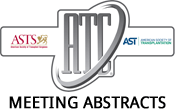2022 American Transplant Congress
Generation and Functional Characterization of Bio-Engineered Livers for Heterotopic Implantation in Porcine Model of Acute Liver Failure
*Purpose: Liver transplantation has shown to be an effective therapy for the end-stage liver diseases (ESLD). However, as donor organ shortages increase, organ engineering technology…2022 American Transplant Congress
Evolution of the Need for Transplant Evaluations for Liver Failure Decompensation After TIPS
*Purpose: Portal hypertension is described as an increased pressure gradient between the portal and systemic circulation which can result in severe complications. Transjugular Intrahepatic Portosystemic…2022 American Transplant Congress
Race Inequity in Liver Transplant Waitlisting: Effect Modification by Psychosocial Factors and the Stanford Integrated Psychosocial Assessment for Transplant
*Purpose: Race inequity in liver transplantation (LT) has been a longstanding area of injustice within the field of hepatology. Information from psychosocial evaluations and The…2022 American Transplant Congress
A Population-Based Analysis of Long-Term Outcomes Following Pediatric Acute Liver Failure Highlights High Risk Populations in Access to Transplant
*Purpose: Pediatric acute liver failure (PALF) is a potentially devastating illness that affects otherwise healthy children. Nearly 70% of children with PALF will recover, while…2022 American Transplant Congress
Pediatric Acute Liver Failure: Patient Factors Associated with Higher Mortality
*Purpose: Pediatric acute liver failure (PALF) is characterized by sudden onset deteriorating liver function, progressive coagulopathy, and hepatic encephalopathy in previously healthy children. The clinical…2022 American Transplant Congress
Covid-related Neonatal Cholestasis?: Liver Transplantation In Three Infants With Intrauterine Or Perinatal Covid Exposure
1Baylor College of Medicine, Houston, TX, 2Baylor College of Medicine, Houston, TX
*Purpose: The COVID pandemic presents a unique set of challenges during pregnancy including thromboembolic complications, direct placental infection, transplacental transmission, and systemic hyperinflammatory state. The…2022 American Transplant Congress
Adult-to-Adult Living Donor Liver Transplantation in Acute Liver Failure – Do Outcomes Justify the Risks?
*Purpose: Living-donor Liver Transplantation(LDLT) has emerged as a safe and effective alternative in children and adults with pre-existing liver diseases. Utilization of LDLT for patients…2021 American Transplant Congress
Simultaneous Heart-Liver-Kidney Transplantation Survival: National and Single-Center Outcomes
*Purpose: Simultaneous Heart-Liver-Kidney transplantation (SHLKTx) is an incredibly rare, high-risk operation undergone by well-selected patients presenting with multi-organ failure. Our center has performed 10 of…2021 American Transplant Congress
A Shift in Paradigm: Phosphatidylethanol Testing to Monitor for and Address Alcohol Recidivism Following Liver Transplantation
*Purpose: Phosphatidylethanol (PEth) is a phospholipid that forms in the presence of ethanol with a long half-life compared to other alcohol detection tests. PEth testing…2021 American Transplant Congress
SARS-CoV-2 Infection in Solid Organ Transplant Recipients: A Retrospective Cohort Study
Infectious Diseases, University of Massachusetts, Worcester, MA
*Purpose: Initial studies of COVID-19 in solid organ transplant (SOT) recipients demonstrated high mortality rates, but more recent comparative data shows contradictory results.*Methods: We evaluated…
- 1
- 2
- 3
- …
- 7
- Next Page »
